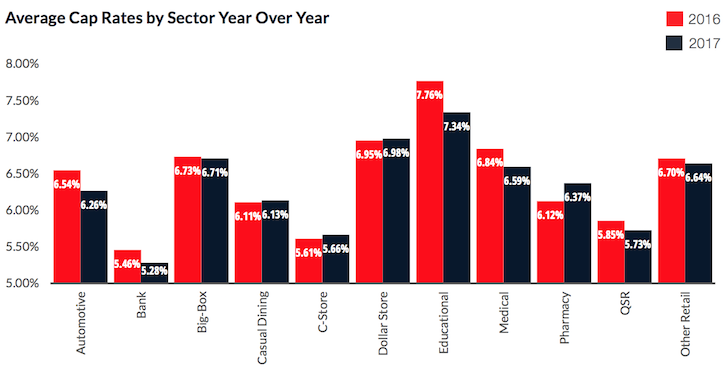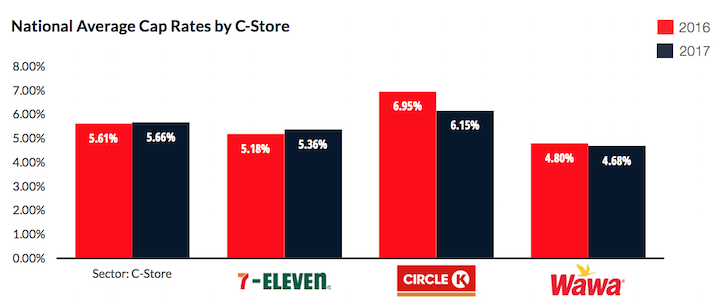 The following is a guest post by Bill Lanting | Vice President, Commercial Debt, RealtyShares. I met Bill over dinner and asked him to share his wisdom about triple-net properties because such investments sound attractive to someone who doesn’t want to do much managing or remodeling.
The following is a guest post by Bill Lanting | Vice President, Commercial Debt, RealtyShares. I met Bill over dinner and asked him to share his wisdom about triple-net properties because such investments sound attractive to someone who doesn’t want to do much managing or remodeling.
Savvy investors seek the most return for the least amount of effort. Therein lies the appeal of triple-net properties, which offer the chance to work with major commercial tenants while at the same time handing off some of the biggest responsibilities any property owner will face.
Triple-net may align with your goals if you’re seeking a quirky, little-known investment type that is better known for reaping rewards than requiring repairs. If this resonates, read on to find out if this is the right asset class for you.
Triple-Net Property Basics
Triple-net properties hold the tenant or lessee responsible for costs on building insurance, maintenance, and real estate taxes in addition to all other typical fees. Long-term leases are the norm here, often running between one and two decades in length. During the great majority of this time, investors can typically sit back and accumulate profits.
The key to a successful triple-net investment lies in two elements: smart lease structure and finding a reliably profitable tenant. Given that triple-net mandates that the tenant shoulders the cost of maintaining the property, this structure presents a relatively low-risk and profitable investment opportunity.
Investors who don’t want to bother with property management while preserving capital and enjoying an assured income stream often opt for triple-net opportunities. Additionally, investors seeking to replace a 1031 Exchange property may find these deals attractive as well given the relative lack of involvement and regular rent payments.
The tax benefits are particularly appealing if you, as the investor, come bearing significant assets such as a business or house along with the intent to sell these for a major gain. Investors of this type are often able to avoid capital gains taxes by using triple-net leases in a 1031 Exchange.
Moreover, triple-net investors are able to use depreciation as a means of lowering their property taxes. Items that can be depreciated include roads, shrubbery, office machinery, appliances, and additions or improvements such as a new roof.
Which Operators and Tenants Opt for Triple Net?
While you will find office and industrial operators amongst the clutch of triple-net tenants out there, the majority of those who choose this lease structure manage retail properties such as convenience stores, fast-food restaurants, big-box stores, grocery stores, and gas stations. Additionally, government entities and agencies have also proven to be good candidates for triple-net leases given their longevity and consistency.
Money-conscious tenants may also choose a triple-net structure since rents tend to be lower. Moreover, depending on your geographic area, triple-net leases may be the norm for commercial properties.
Triple-net leases are popular among the multi-tenant industrial and retail property sets, users whose expenses can vary greatly. Such a lease structure is also beneficial to the landlord as the costs are passed along to the tenant, who then has the incentive to keep costs low since they are footing the bill.
Business operators may find a stronger incentive to lease rather than buy a given property when seeking to develop a triple-net franchise given that build-to-suit is gaining favor. In such a scenario, once the lease is signed, the property owner builds, for example, a Bank of America. Then the business operator can focus on his core strengths—in this case, operating a neighborhood bank branch.
Because it’s triple net, the business operator maintains the building while paying insurance and property taxes. If everything’s going according to plan, they pay their lease and can still take home their business profit. So everybody’s happy.

Source: Calkain Research, Net Lease Company
What is the Value Proposition?
Investors find plenty of value in triple-net leases given that they can offload responsibility for insurance, maintenance, and taxes while pulling in a steady stream of consistent profit on a long-term lease. Moreover, these leases are typically inked with quality tenants and provide strong tax benefits.
For their part, tenants appreciate lower rents in exchange for taking on the responsibility of management duties. Highest-rated tenants tend to encounter a 6 percent cap rate, which goes up to an estimated 8.5 to 9 percent for less creditworthy parties.
Finally, operators find their own value proposition in the fact that they can sell their property to an investor but remain in the business as a long-term triple-net tenant – a tactic known as a sale-leaseback. By doing this, the operator gets a return on an asset that was previously illiquid.
Why might investors sock their money into an existing triple-net deal rather than just buying and/or developing such a property themselves? Simply put, they don’t have the capital; a Church’s Chicken in a second-tier market can easily go for $2.2 million.
Additionally, while triple-net maintenance is minimal relative to other property types, it’s still too much for some prospective investors. As with all properties, the owner is ultimately on the hook for tax reporting and monitoring building condition—and if the tenant is unable to make rent, the owner is left holding the bag.

Convenience stores are more defensive when it comes to e-commerce. Source: Calkain Research, Net Lease Company
How Can Triple-Net Properties Integrate into a Diversified Portfolio?
RealtyShares has underwritten more than 10 triple-net (NNN) loans. These loans are available only to creditworthy franchisees operating stable nationwide franchises such as Taco John’s, Church’s Chicken, Checkers, and Dog Haus.
Generally speaking, Triple-net opportunities are comparatively stable investments. The opportunities RealtyShares has underwritten have had solid return objectives with lower risk to investors, as opposed to commercial equity deals which have higher return objectives with higher risk potential. To date, we have had no defaults on our triple net deals.
Triple-net investments may be a boon to your bottom line for two reasons. First, stability is tantamount to sustainability. Triple-net properties last longer because these business – such as coffee shops and fast food – are not only impermeable to e-commerce competition but are also more recession-resistant. Second, integrating triple-net properties into your portfolio helps you further diversify, which is essential to avoiding market turbulence.
How Can Individual Accredited Investors Take Advantage of These Deals?
Buy-and-hold is the heart of triple-net investing, and its principal value lies in tenants rather than features. As an individual investor, one is well advised to consider a tenant’s financial profile when calculating its potential.
Favorites among this set include blue-chip tenants including major chain franchisees and national credit tenants, which means a tenant given an investment-grade rating for its financial strength and size. Such ratings signal to property owners that tenants can withstand a variety of economies, including turbulent ones.
Can You Benefit from Triple-Net Properties?
When RealtyShares users opt to invest in a triple-net property, they can expect to enjoy a predictable flow of reliable returns given that said returns are funded by tenants’ rent payments.
However, investors are well advised to remember that purchasing at a lower cap rate – particularly if rental increases are either low or nonexistent – will probably not bring high average returns. This is especially true when one considers inflation. Other factors affecting triple-net returns include tax obligations and miscellaneous property-related expenses.
That said, if you’re seeking tax benefits plus monthly income without the need for a large time investment, this asset class may be right up your alley. In taking an armchair approach to ownership, you can enjoy a stable ROI minus the hassle of property management.
With real estate investing in general, think in terms of market cycles. During the initial days of a recovery, concentrate on development; as that recovery becomes more grounded, shift your attention to balance between high-yield core properties, light-value add properties, repositioning/reconfiguring properties, and entitlement/development properties. Ease off the latter once structural vacancy begins to rise nationwide.
Related:
Buy Utility, Rent Luxury When Investing In Real Estate
Ranking The Best Passive Income Investments
Readers, any of you currently invested in triple-net properties? What are some other upsides and downsides to triple-net properties one should be aware of? I currently have $810,000 invested in RealtyShares, and am always looking for ways to earn passive income.
The post Triple-Net Properties: An Ideal Source Of Passive Income appeared first on Financial Samurai.
No comments:
Post a Comment